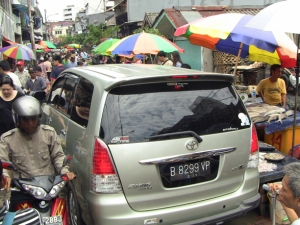Tonight I attended a presentation by a couple of researchers from the World Bank. One of them made the “counterintuitive” assertion that Jakarta’s public transportation required greater density. He then mentioned, among other places, Curitiba, Brazil – the home of Bus Rapid Transit – as a model. When I spoke with him afterward, he again contended that 1) greater density, by itself, would lead to improved public transit in Jakarta and 2) Curitiba was denser.
So what’s wrong here?
First, if Wikipedia is to be believed, Jakarta is about 3.5 times as dense as Curitiba. In fact, it’s one of the densest cities in the world, denser even than New York, which has a great transit system, too. So higher density doesn’t automatically lead to better transit.
Second, the demand for public transportation in Jakarta is already high. In fact, the bus I took to the presentation was so packed with people that my arm was pinned in place, and people waiting at subsequent stops didn’t even try to squeeze on-board. Riding the commuter train can be similar.
Rather than greater density of people, what Jakarta needs is a variety of changes, some of which lie within the purview of policymakers. Let’s hope that economists haven’t convinced them to magically make everything better by encouraging higher density.
So where did the World Bank researcher’s assertion come from?
When I asked him for a specific study on Jakarta that I might peruse, he said that his comments derived, rather, from general principals supported by the work of prominent urban economists. The first he named is Edward Glaeser. So I looked him up.
My cursory review of interviews with Glaeser and synopses of his work suggests that he contends that density brings trade-offs but that the balance ultimately is always positive. Regarding transportation, he argues not that mass transit will automatically improve with growing density – thus not supporting the World Bank researcher’s contention – but that, even if people continue to drive, the distances driven will be shorter, reducing pollution. This is reasonable, but there are questions such as whether people will then drive to the suburbs to shop, as in New Orleans and Atlanta; whether gridlock will increase, with idling offsetting the gains in propinquity; whether the concentration of pollutants and people might be worse for health, although not for climate change … Detailed observation is needed.

